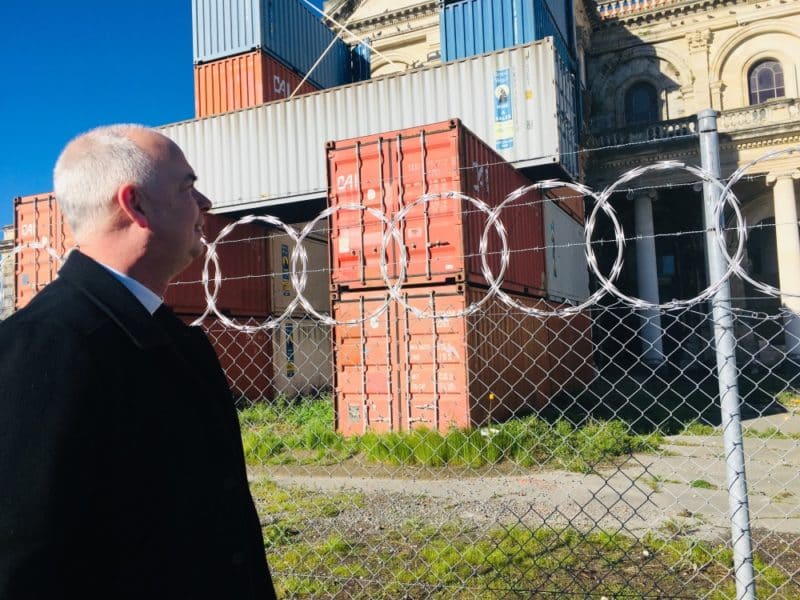by MINA AMSO
It took nine years and three million dollars to maintain and investigate possible options that would keep the Cathedral of the Blessed Sacrament in Christchurch from demolition.
However, the Catholic Bishop of Christchurch publicly announced on Sunday, August 4, his decision to demolish the 113-year-old cathedral.
“To this point, we have taken our time to ensure we make the right decision
and we will continue to be both wise and cautious as we look at our next steps,” said Bishop Paul Martin, SM.
To fully restore the earthquake-damaged cathedral, the cost would have been an estimated $149 million. Saving only the nave and “rebuilding on a modest scale” would have cost an estimated $91 million.
“And the big worry is that with restoration-type work these costs can escalate quickly,” Bishop Martin said.
Bishop Martin has budgeted $40 million to build a new cathedral. Some $30 million was set aside by the late Bishop Barry Jones for the cathedral from the diocese’s insurance pay out. That money was also available to go towards fixing other damaged buildings throughout the diocese.
The $30 million will now go towards building the new cathedral, and the remaining $10 million would need to be fundraised by the Catholic community, Bishop Martin said.
The decision to demolish the Barbadoes Street cathedral was announced in a pastoral letter from Bishop Martin, which was read out during August 4th Sunday Masses throughout the diocese.
In 2015, the Canterbury Earthquake Recovery Authority (CERA) had issued a Section 38 notice, which allowed for the deconstruction of the cathedral, in the quest to see if the nave and other parts could be saved.
Bishop Jones undertook this application in the hope that he might be able to save parts of the cathedral — the nave of the church, and then build more modest bell towers and a new sanctuary.
“Bishop Barry was keen for this option to be investigated as long as it fitted within the financial framework he set,” Bishop Martin said.
The pastoral letter stated that part of the conditions for fulfilling the requirements of the Section 38 was to pass a 12-point test to assess the functionality of the building and its financial viability.
When looking at the options, the first to save the nave did not pass on the functionality or financial tests, and the second to restore the whole building did not pass the financial viability requirements.
Bishop Martin said 20 different options had been considered, however not a single one was both functional and financially viable.
The Section 38 also gave Christchurch diocese the power to demolish the building entirely if it was found that it could not pass the 12-point test outlined in the application.
The decision to demolish the building took place after wide consultation involving experts from New Zealand and overseas as well as the bishop’s own advisory group including the College of Consultors, diocesan management and finance board and diocesan staff.
Bishop Martin said he had informed Land Information New Zealand of “our desire to begin the process of deconstruction”.
The bishop noted that this decision allows the diocese to look at other locations that will make the cathedral more accessible, more suitable and more appropriate as a place of worship. It will be a “living building” to serve our community, it was stated.
“We are still exploring new sites, therefore we do not have a design, but we are excited about the future.”
Bishop Martin said having a new site for the cathedral will be an “integral part of the new parish structure proposed for the city”.
He said building the new cathedral on the current Barbadoes Street site was an option.
“[But] I’ve been very clear that my preference is to be in the heart of the city,” he said.
Bishop Martin is “very interested” in a site near Victoria Square, which could accommodate the new cathedral.
“It would be right in the heart of the city and all the things we like to do. But we haven’t secured all of that. I can’t confirm that.”
“Part of it is working with the people who own the land [near Victoria Square] . . . But, if and when that happens, then we would [investigate it a little further].”
In the pastoral letter, Bishop Martin spoke of the “reality” of and “sadness” at the damage done to the cathedral during the 2010 and 2011 earthquakes.
“I feel sad about it [the decision to demolish]. But I also know, in order for us to be able to move on with the life of our diocese, we have to make a decision and move on, and that’s what I’ve had to do. So, in that sense, I am at peace with it, even though it’s not a nice decision we have to make.”
He said allowances should be made for the “honouring and celebrating of this holy place as a diocese as part of this grieving process”.
Bishop Martin said the cathedral has been “a wonderful point of unity and prayer and witness to God”.
“The work of our forebears and all those who have followed, including many of you, has made this such a blessed place.”
In the pastoral letter, the bishop stated “we will work hard to ensure that sacred elements from the cathedral will be kept if possible, while also respecting the need for safety for those who will be tasked with deconstructing it. This is still a dangerous building and its deconstruction will take a lot of careful planning and execution”.
The three bishops who are currently buried onsite will have be removed and interred elsewhere.
Bishop Martin said that no timetable has been set for demolition to start, but he was keen to work with engineers and safety experts to see if an event could be held on the cathedral grounds for parishioners to say farewell.

Reader Interactions